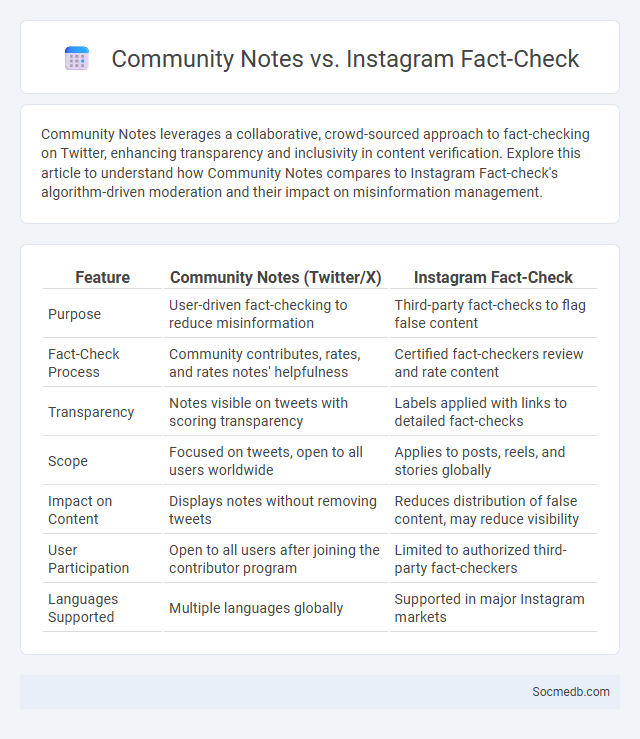
Photo illustration: Community Notes vs Instagram Fact-check
Community Notes leverages a collaborative, crowd-sourced approach to fact-checking on Twitter, enhancing transparency and inclusivity in content verification. Explore this article to understand how Community Notes compares to Instagram Fact-check's algorithm-driven moderation and their impact on misinformation management.
Table of Comparison
| Feature | Community Notes (Twitter/X) | Instagram Fact-Check |
|---|---|---|
| Purpose | User-driven fact-checking to reduce misinformation | Third-party fact-checks to flag false content |
| Fact-Check Process | Community contributes, rates, and rates notes' helpfulness | Certified fact-checkers review and rate content |
| Transparency | Notes visible on tweets with scoring transparency | Labels applied with links to detailed fact-checks |
| Scope | Focused on tweets, open to all users worldwide | Applies to posts, reels, and stories globally |
| Impact on Content | Displays notes without removing tweets | Reduces distribution of false content, may reduce visibility |
| User Participation | Open to all users after joining the contributor program | Limited to authorized third-party fact-checkers |
| Languages Supported | Multiple languages globally | Supported in major Instagram markets |
Understanding Community Notes: A Collaborative Approach
Community Notes leverages collective input from users to provide additional context and combat misinformation on social media platforms. This collaborative approach enhances the accuracy and reliability of content by allowing your community to fact-check and annotate posts in real-time. Understanding this mechanism helps you engage more critically with shared information and contribute to a safer, more informed online environment.
What Is Instagram Fact-Check?
Instagram Fact-Check is a content verification feature designed to combat misinformation by labeling and reducing the spread of false information across the platform. It collaborates with third-party fact-checking organizations certified through the International Fact-Checking Network to review and assess posts flagged for accuracy. This tool helps users identify reliable information by providing context and warnings on potentially misleading images, videos, or claims shared within Instagram's social media ecosystem.
How Does Community Notes Differ from Instagram Fact-Check?
Community Notes leverages a broad network of volunteer contributors who collaboratively add context and corrections to potentially misleading content on platforms like Twitter, promoting transparency and collective verification. Instagram's Fact-Check program relies on a network of third-party professional fact-checking organizations that review and label content based on accuracy standards. The key difference lies in Community Notes' community-driven approach versus Instagram's reliance on expert fact-checkers to evaluate misinformation.
Transparency and Accountability: Comparing Systems
Social media platforms vary significantly in transparency and accountability, with open-source networks like Mastodon offering greater user control and clearer content moderation policies compared to opaque algorithms used by Facebook and Instagram. Facebook's algorithmic decisions often lack transparency, leading to challenges in addressing misinformation and bias, whereas platforms with public content guidelines and community-led moderation demonstrate higher accountability levels. Regulatory frameworks such as the EU's Digital Services Act are pushing major social networks toward increased transparency in data handling and content moderation practices.
User Participation in Fact-Checking: Community Notes vs Instagram
User participation in fact-checking varies significantly between Community Notes and Instagram, with Community Notes leveraging a collaborative approach that enables a wide range of users to contribute to verifying content accuracy. Instagram primarily relies on a combination of AI and selected third-party fact-checkers, offering less direct involvement for your community in the verification process. Community Notes' open model enhances transparency and trust by allowing your active engagement in flagging misinformation, while Instagram maintains tighter control over content moderation to reduce misinformation spread.
Speed and Accuracy of Corrections
Social media platforms have enhanced the speed and accuracy of corrections by enabling real-time updates and fact-checking mechanisms that promptly address misinformation. Advanced algorithms and AI-driven tools help detect false content quickly, ensuring users receive accurate information with minimal delay. This rapid correction capability significantly improves the reliability and trustworthiness of social media as an information source.
Impact on Misinformation Control
Social media platforms play a critical role in misinformation control by enabling rapid dissemination and detection of false information through advanced algorithms and user reporting systems. Your ability to critically evaluate content and rely on verified sources significantly reduces the spread of misleading narratives. Enhanced fact-checking initiatives and AI-driven content moderation continuously improve the accuracy and reliability of information shared online.
Limitations and Criticisms of Each Method
Social media platforms face significant limitations including data privacy concerns, algorithmic biases, and the spread of misinformation, which undermine user trust and content reliability. Each method of content moderation, from automated filtering to community reporting, struggles with balancing censorship and free expression while often lacking transparency and consistency. Furthermore, the rapid evolution of social media trends poses challenges in adapting policies swiftly, leading to gaps in addressing harmful behavior effectively.
Trust and Public Perception
Trust in social media platforms significantly influences public perception, shaping user engagement and brand reputation. Algorithms that prioritize transparency and content authenticity enhance user confidence, reducing the spread of misinformation. Public perception improves when platforms actively combat fake news and protect user privacy through robust security measures.
The Future of Social Media Fact-Checking
The future of social media fact-checking relies heavily on advanced AI algorithms and machine learning to swiftly identify and flag misinformation across platforms like Facebook, Twitter, and Instagram. You can expect real-time verification tools and enhanced collaboration between tech companies and independent fact-checkers to improve content accuracy. These innovations aim to foster a more trustworthy digital environment by minimizing the spread of false news and promoting informed online interactions.
 socmedb.com
socmedb.com